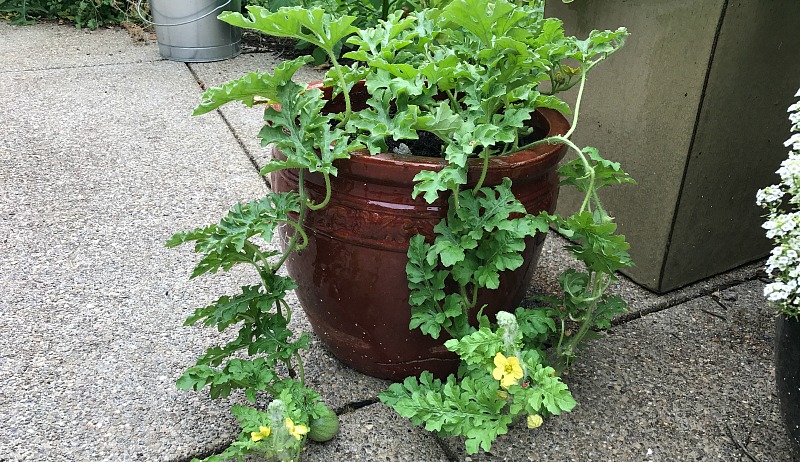
It seems that gardeners are increasingly turning to containers to grow vegetables, not only to maximize yields but also to reduce maintenance needs. That said, some veggies are harder to grow in pots than others, and among the most challenging is the watermelon.
The vines of most watermelon varieties grow as long as 10 feet, making them a tough crop for container gardeners trying to save space. Watermelons also have thirsty roots that require frequent irrigation, and each vine produces only one or two melons, a yield that’s far from ideal for space-starved gardeners.
Thankfully, growing watermelons in containers is now possible (and super-fun!) thanks to a relatively new container-friendly variety called sugar pot watermelon.
About Sugar Pot Watermelon
Sugar pot watermelon vines stay very compact, reaching just 18 to 20 inches in length, but the fruits it produces are a decidedly hearty 8 to 10 pounds each. The flesh is sweet and red with pure watermelon flavor.
I grew sugar pot watermelon on my patio last summer for the first time, and I had great success. Here’s the technique I used.
How to Grow Sugar Pot Watermelon in Containers
Step 1: Choose a Large Container
For sugar pot to perform its best, you’ll need a minimum of 7 to 10 gallons of potting soil for each vine. Last year, I grew three sugar pot watermelon plants in a 30-gallon glazed-ceramic pot. The plants did quite well and the pot didn’t dry out all the time.
Step 2: Fill the Pot With the Right Soil
Since watermelons are fairly heavy feeders that do not like to dry out, a high-quality potting mix blend is a must. To grow my sugar pot watermelons, I mixed my favorite organic potting soil with finished compost at a 50/50 ratio. The potting soil keeps the mixture light and well draining while the compost aids in moisture retention and introduces nutrients and beneficial soil microbes to the plants.
Step 3: Sow the Seeds of Sugar Pot Watermelon
Plant one to three seeds per pot, depending on the size of the container. (See Step 1 above.) Bury each seed to a depth of about one inch, and water them in well.
Step 4: Put the Pot in Full Sun & Keep Plants Watered
After planting the seeds, make sure the soil stays continually moist, all the way through harvest time. Do not, however, allow any water to sit in a saucer beneath the pot as that can lead to root rot. You should also not subject the vines to extended dry periods followed by lots of irrigation, especially when the fruits are nearly ripe as this can cause the fruits’ skins to crack open or the flavor to be diluted.

Step 5: Fertilize
Even though the compost you added to your container will provide some nutrients to your sugar pot watermelon vines, they’ll still need supplemental fertilization during the growing season. I use liquid fish emulsion or an organic liquid fertilizer to feed all my container-grown vegetables every three weeks, starting when the seedlings develop their first true leaves.
Step 6: Harvest the Fruits
Sugar pot watermelons reach maturity 80 to 85 days after sowing the seeds. To check for ripeness, look for a yellow spot on the underside of the fruit. Also check the curly tendril closest to where the fruit’s stem attaches to the vine. When that curly tendril turns completely brown and dies, that’s a sign the melon is ready for harvest. Do not pick watermelons too early as they will not ripen once severed from the vine.
Ripe watermelons will not separate from their stem; instead, you’ll have to cut the melon from the vine with a pair of pruners or a sharp knife.
Seeds of sugar pot watermelon are available from Territorial Seed and Log House Plants.




